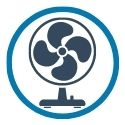
Pro Tips for Staying Cool
Lower your summer cooling costs without sacrificing comfort:
- Set the air conditioning thermostat at 78 degrees or your highest comfortable setting. Higher settings cost less; lower settings cost more.
- Don’t try to speed-cool at a very low temperature setting when you return home from work or school. Your AC won’t cool any faster set at 68 degrees than it does at 78 degrees.
- If you have ceiling fans, run the fans and the air conditioner at the same time, but set the air conditioner thermostat a few degrees higher. A fan’s breeze on your skin increases evaporative cooling. You’ll feel cool at a higher room temperature, which can save a lot.
- Ventilate to keep heat from building up. Turn on your exhaust fans in the kitchen and in bathrooms when they are in use and even for some time after. Use ceiling fans, which will circulate the air in a room and allow you to raise the thermostat setting about 4°F while keeping the same level of comfort. But...
- Turn off fans when you’re away. A fan’s motor adds a small amount of heat to a room.
- Use a microwave instead of the range/oven, or cook outdoors.
- Change the air conditioner’s air filter monthly during heavy use. When the filter is clogged, air flow is restricted and cooling costs rise. A badly clogged filter can lead to compressor failure with a $1,000+ repair bill. Check the evaporator coil every year and remove dust there as well.